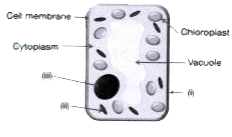One of these is not a function of the non-living layer of the cell
gives shape to the cell
protects the cell from damage
synthesizes hormones
helps in cell to cell interaction
The correct Answer is:C
To solve the question regarding the functions of the non-living layer of the cell, we can follow these steps:
1. Identify the Non-Living Layer of the Cell:
- The non-living layer of the cell is known as the cell wall. It is a rigid structure that surrounds the plasma membrane in plant cells and fungal cells.
2. List the Functions of the Cell Wall:
- The cell wall has several key functions:
- Gives Shape to the Cell: It provides structural support and maintains the shape of the cell.
- Protects the Cell from Damage: It acts as a protective barrier against mechanical damage and pathogens.
- Helps in Cell-to-Cell Interaction: It facilitates communication and interaction between adjacent cells.
- Prevents Entry of Undesirable Macromolecules: It acts as a barrier to prevent harmful substances from entering the cell.
3. Evaluate the Given Options:
- The question presents four options:
1. Gives shape to the cell
2. Protects the cell from damage
3. Synthesizes hormones
4. Helps in cell-to-cell interaction
- From the functions listed, options 1, 2, and 4 are indeed functions of the cell wall.
4. Identify the Incorrect Function:
- The function that is not associated with the non-living layer (cell wall) is option 3: Synthesizes hormones. Hormone synthesis occurs within living cellular structures, not in the cell wall.
5. Conclusion:
- Therefore, the correct answer to the question is option 3: Synthesizes hormones.
- The non-living layer of the cell is known as the cell wall. It is a rigid structure that surrounds the plasma membrane in plant cells and fungal cells.
- The cell wall has several key functions:
- Gives Shape to the Cell: It provides structural support and maintains the shape of the cell.
- Protects the Cell from Damage: It acts as a protective barrier against mechanical damage and pathogens.
- Helps in Cell-to-Cell Interaction: It facilitates communication and interaction between adjacent cells.
- Prevents Entry of Undesirable Macromolecules: It acts as a barrier to prevent harmful substances from entering the cell.
- The question presents four options:
1. Gives shape to the cell
2. Protects the cell from damage
3. Synthesizes hormones
4. Helps in cell-to-cell interaction
- From the functions listed, options 1, 2, and 4 are indeed functions of the cell wall.
- The function that is not associated with the non-living layer (cell wall) is option 3: Synthesizes hormones. Hormone synthesis occurs within living cellular structures, not in the cell wall.
- Therefore, the correct answer to the question is option 3: Synthesizes hormones.
Similar Questions
Knowledge Check
- Question 1 - Select One
A non-living structure of cell is
ACell wallBPlasma membraneCCytoplasmDNucleus - Question 2 - Select One
the non-living part of a tomato cell is its
Acell membraneBnucleusCchloroplastsDcell wall - Question 3 - Select One
The precursor for the formation of this layer of the cell walls cell plate
APrimary wallBMiddle lamellumCSecondary wallDTertiary wall
The plant cell has different organ which perform various functions. In addition to the cell membrane, plant cells also have another layer around them called the cell wall. This rigid layer is not present in animal cells. It is made up of a non-living material called cellulose Check the below figure and try to answer the following questions

Explain the main function of cell wall in plant cellView SolutionThe function of ozone layer in stratosphere is
View SolutionWhich one of the following is not the function of cnidoblasts (sting cell) ?
View SolutionMain function of middle layer is
View SolutionThe first wall layer of cell is
View Solution

